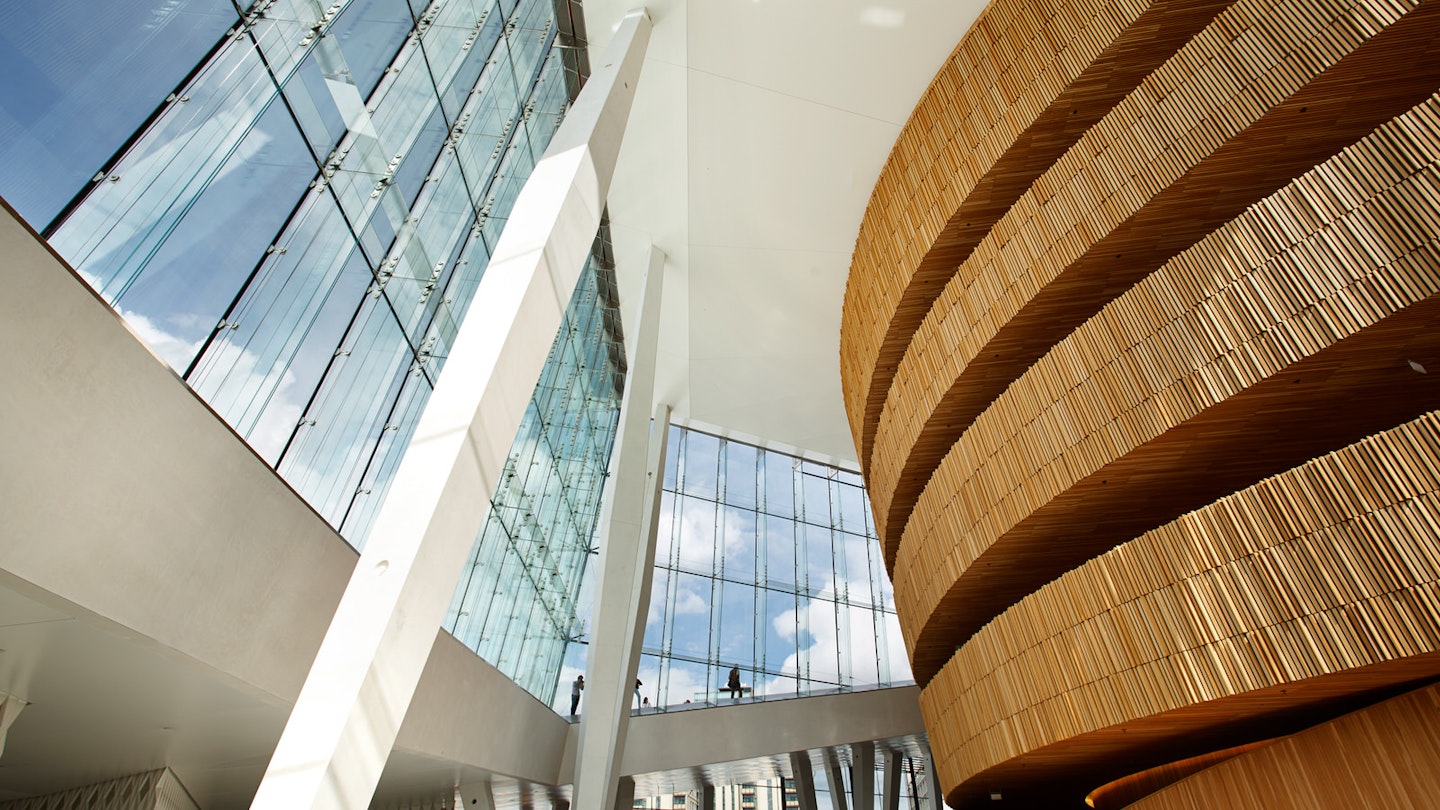Contemporary Architecture in Oslo
Contemporary architecture in Oslo may not be the first thing that comes to mind when envisioning the city. However, the Norwegian capital has unveiled a slew of adventurous buildings in the last decade, ranging from innovative museums to striking opera houses.
Oslo Opera House
The city’s flagship piece of contemporary architecture, the opera house, has emerged as a striking symbol of Oslo’s architectural renaissance. A blend of white granite, aluminum, and glass, it features intersecting planes that rise majestically above the water. This visually dynamic building is designed to take full advantage of its stunning fjordside location. Inside, ample glass windows bathe the space in natural light, complemented by warm, glossy oak finishes that reflect Norway’s heritage of functional woodwork. Designed by the renowned architecture firm Snøhetta, this masterpiece has garnered international acclaim.

Astrup Fearnley Museum
Every modern city needs an art museum designed by a superstar architect. In Oslo, that museum is the Astrup Fearnley – a shimmering, sail-shaped assembly of three pavilions beneath a glass roof. Designed by the celebrated Italian architect Renzo Piano, the museum incorporates rigged cables and slender steel columns, evoking the tall ships that once graced Oslo’s harbor. Inside, the stark white spaces provide a radiant backdrop for numerous artworks, including pieces by Jeff Koons, Francis Bacon, and Edvard Munch. The adjacent Tjuvholmen Sculpture Park enhances the artistic experience, creating an immersive cultural environment.

The Barcode
This striking row of 12 apartment and office buildings along the Bjørvika waterfront challenges traditional perceptions of high-rise architecture. Each structure showcases unique design elements contributed by different architectural firms. Collectively, they form an engaging ensemble, and their spacing gives rise to the area’s playful nickname, “the Barcode,” due to the intriguing visual contrasts when viewed from afar.

Statoil Building
Despite being the headquarters of Norway’s largest oil company, the Statoil Building is anything but mundane. Its innovative design features five white, rectilinear columns stacked like a massive game of spillikins, reportedly inspired by offshore oil rigs. This futuristic structure resembles a scene from a sci-fi film. Clad in aluminum with intricate rectangular windows, the building makes a bold design statement, though public access is unfortunately limited.

Akrobaten Bridge
Extending 206 meters, the Akrobaten Bridge connects the Grøenland and Bjørvika neighborhoods, gracefully spanning the railway tracks near Oslo’s main train station. Its sleek steel structure, supported by a web of shiny metal tubes, resembles a molecular design from a science class. Stunning during the day, it truly comes to life at night when a vibrant light display highlights its architectural features.

Holmenkollen National Ski Arena
The Holmenkollen National Ski Arena stands as a testament to Norwegians’ passion for skiing. This thrilling winter sports venue features a dramatic ski jump and is, remarkably, the most visited attraction in Norway. Built in 2011 for the Nordic World Ski Championships, the sports arena was constructed at an estimated cost of 1.7 billion Norwegian kroner (approximately $213 million) and has undergone multiple renovations in its long history, emphasizing the nation’s dedication to skiing.

National Gallery
While Oslo’s contemporary architecture garners much of the spotlight, the city also boasts numerous splendid historical buildings. Notably, the Akerhus Festning medieval castle stands as a significant landmark. However, for many, the reigning architectural gem is the National Gallery – a magnificent red-brick structure constructed in 1882 to showcase Norway’s artistic treasures. Featuring arched windows, expansive halls, and an air of restrained grandeur, this landmark elegantly displays masterpieces by iconic artists such as Picasso, Monet, and Edvard Munch, including the renowned The Scream.

Viking Ship Museum
The Viking Ship Museum is dedicated to two of the best-preserved Viking longships ever discovered, along with fragments of a third. This museum illustrates the harmonious coexistence of Oslo’s new and traditional architecture, although redevelopment plans are still being finalized. A new exhibition space, designed by Denmark’s AART Architects, aims to incorporate the original museum into a new circular structure known as ‘Naust’ (Norwegian for boathouse). Although construction isn’t set to begin until 2020, the current display of these remarkable Viking vessels offers a glimpse into Norway’s rich maritime history.






